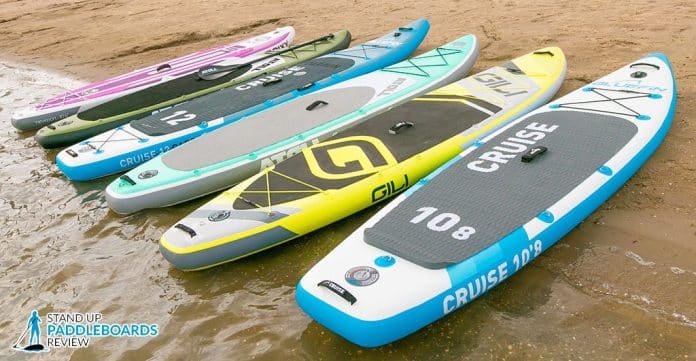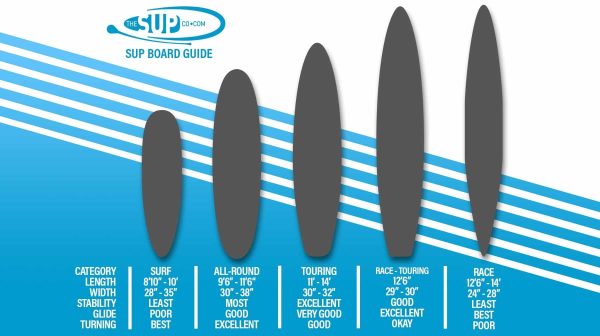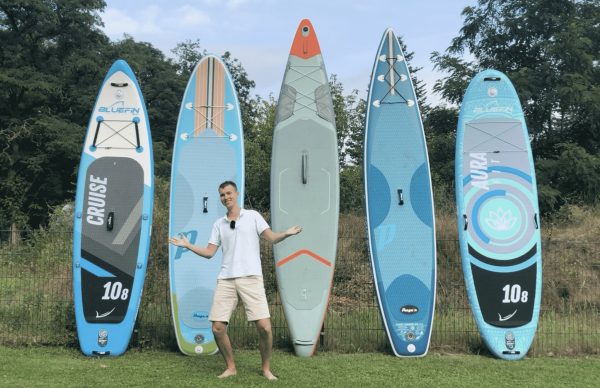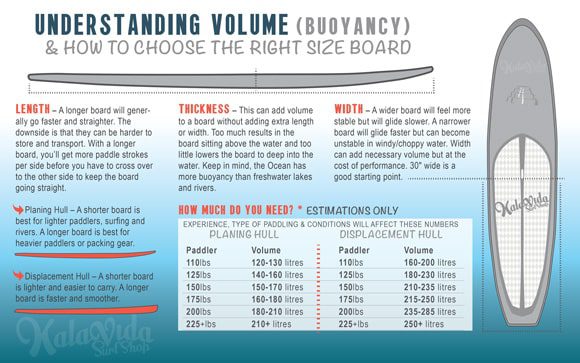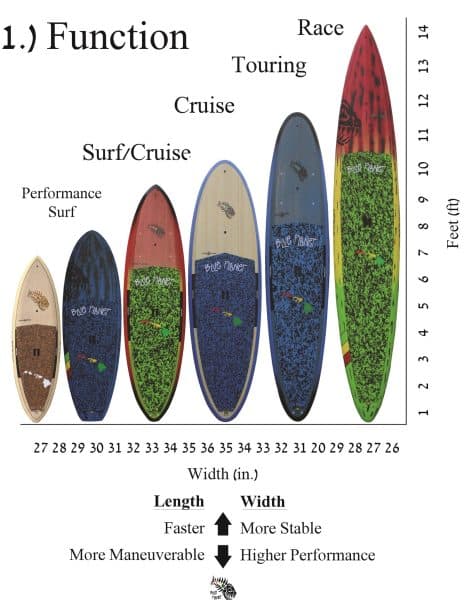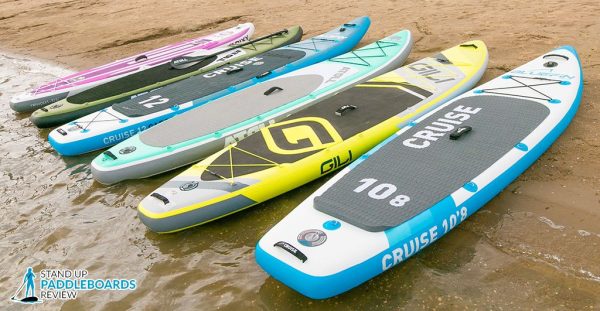Choosing the right SUP board can be daunting, especially for beginners. With many options available on the market, it’s easy to feel overwhelmed.
But fear not! This article will guide you through selecting a good SUP board that suits your needs and preferences.
From considering factors like size and weight to understanding the different types of boards available, we’ve got you covered.
So, whether you’re planning to surf waves or paddle on calm lakes, discover the key factors to consider before purchasing.
Type of SUP Board
When choosing a stand-up paddle (SUP) board, several options exist. The type of SUP board you choose will largely depend on the activities you plan to do on the water. Here are the most common types of SUP boards:
Inflatable SUP Board
Inflatable SUP boards have gained popularity recently for their convenience and portability. These boards are made from durable materials and can be easily inflated and deflated for storage and transportation. Inflatable SUP boards are an excellent option for beginners or anyone who values easy storage and transportation.
Epoxy SUP Board
Epoxy SUP boards are made from a foam core wrapped in fiberglass and epoxy resin layers. These boards are more rigid and perform better than inflatable SUP boards. Epoxy SUP boards are popular among experienced paddlers and are suitable for various activities, from casual paddling to racing.
All-around SUP Board
All-around SUP boards are versatile boards designed to perform well in various water conditions. These boards are usually a good choice for beginners or those who want to do a bit of everything, from flatwater paddling to small waves. All-around SUP boards typically have a balanced shape, offering stability and maneuverability.
Touring SUP Board
Touring SUP boards are designed for long-distance paddling and exploring. These boards are longer and narrower than all-around SUP boards, providing better glide and tracking in the water. Touring SUP boards often have additional features like bungee cords or storage compartments to carry gear for overnight trips or extended adventures.
Surfing SUP Board
Surfing SUP boards are specifically designed for riding waves. These boards are shorter and more maneuverable than other SUP boards, allowing riders to carve and turn on the face of a wave. Surfing SUP boards often have a more pronounced rocker and a narrower tail, offering better performance in the surf.
Racing SUP Board
Racing SUP boards are built for speed and performance in competitive racing. These boards are long, narrow, and have a streamlined shape to maximize speed and efficiency. Racing SUP boards often feature a displacement hull or a planing hull, depending on the type of racing and water conditions.
Board Length
The length of a SUP board plays a crucial role in determining its performance and suitability for different activities. Here are some factors to consider when choosing the appropriate length:
Factors to Consider
- Skill level: Longer SUP boards provide better stability, making them ideal for beginners. Shorter boards offer excellent maneuverability but require more balance and control.
- Type of activity: Longer boards are better for touring or racing, providing more glide and speed. Shorter boards are more suitable for surfing or navigating tight spaces.
- Body weight: A longer SUP board can support more weight and float higher in the water. Heavier riders may need a longer board for optimal stability.
- Storage and transportation: Longer SUP boards may be more challenging to store and transport, especially for those with limited space or access to a large vehicle.
Recommended Lengths for Different Activities
- All-around SUP: 10-12 feet for beginners, 9-10 feet for intermediate paddlers, and 8-9 feet for advanced riders.
- Touring SUP: 11-14 feet for longer distances and 10-11 feet for shorter trips.
- Surfing SUP: 7-10 feet, depending on the rider’s skill level and wave size.
- Racing SUP: 12-14 feet for flatwater racing and 14-18 feet for open water or ocean racing.
This image is the property of www.thesupco.com.
Board Width
The width of a SUP board also plays a significant role in its stability and performance. Here are some factors to consider when choosing the appropriate width:
Factors to Consider
- Stability: Wider SUP boards offer better stability, making them suitable for beginners or riders who prioritize balance.
- Speed and maneuverability: Narrower boards provide better speed and maneuverability but require more skill and control.
- Type of activity: Wider boards are better for recreational paddling, yoga, or fishing, as they provide a stable platform. Narrower boards are more suitable for racing or surfing.
Recommended Widths for Different Activities
- All-around SUP: 30-34 inches for beginners and 28-30 inches for more advanced riders.
- Touring SUP: 30-32 inches for stability during long-distance paddling.
- Surfing SUP: 28-32 inches for stability and maneuverability on waves.
- Racing SUP: 24-28 inches for speed and performance in competitive racing.
Board Thickness
The thickness of a SUP board affects its buoyancy and stability in the water. Here are some factors to consider when choosing the appropriate thickness:
Factors to Consider
- Buoyancy: Thicker SUP boards offer more floatation and can support more weight. They are ideal for heavier riders or those who need extra stability.
- Flexibility: Thinner SUP boards provide more flex, allowing better performance in waves or rough water conditions.
- Weight: Thicker SUP boards are generally heavier, making them more challenging to handle and transport.
Recommended Thicknesses for Different Activities
- All-around SUP: 4-6 inches for beginners and 4-5 inches for more advanced riders.
- Touring SUP: 5-7 inches for improved glide and stability during long-distance paddling.
- Surfing SUP: 4-5 inches for better wave responsiveness and maneuverability.
- Racing SUP: 5-6 inches for increased speed and efficiency in competitive racing.
This image is the property of www.stand-up-paddling.org.
Board Volume
The volume of a SUP board refers to the amount of space it displaces in the water and is measured in liters. The volume is crucial in determining the board’s stability and weight capacity. Here’s why it’s important and some recommended volumes for different activities:
Importance of Volume
- Stability: Higher volume SUP boards provide better stability, making them ideal for beginners or riders who need extra support.
- Weight capacity: Boards with higher volume can support more weight without compromising performance or stability.
- Paddling experience: Experienced riders may prefer lower-volume boards for better maneuverability and responsiveness.
Recommended Volumes for Different Activities
- All-around SUP: 150-200 liters for beginners, 120-150 liters for intermediate paddlers, and 100-120 liters for advanced riders.
- Touring SUP: 200-300 liters for increased stability and weight capacity.
- Surfing SUP: 80-120 liters for better wave maneuverability and responsiveness.
- Racing SUP: 200-300 liters for optimal speed and efficiency in competitive racing.
Weight Capacity
When choosing a SUP board, it’s essential to consider the weight capacity to ensure that it can safely support you and any additional gear you may have. Here’s how to determine the weight capacity and choose the right one for your needs:
Determining Weight Capacity
- Know your weight: Take into account your body weight and the weight of any gear or accessories you plan to carry on the board.
- Check manufacturer guidelines: SUP board manufacturers usually provide weight capacity recommendations for each model. Consider these guidelines as a starting point.
- Consider your skill level: Beginners may benefit from choosing a board with a higher weight capacity for added stability. More advanced riders may be comfortable with a lower weight capacity.
Choosing the Right Weight Capacity
- Add up the weights: Calculate your total weight, including your body weight, gear, and any additional weight you plan to carry on the board.
- Look for a board with a weight capacity that exceeds your total weight. This ensures the board can support you and your gear without compromising stability or performance.
This image is the property of www.kalavidasurfshop.com.
Types of SUP Boards
A variety of SUP boards are available, each designed for specific activities and conditions. Understanding the different types will help you narrow down your options and choose the best board for your purposes.
- Inflatable SUP Boards: Inflatable SUP boards, also known as iSUPs, are portable and easy to store. They are made from durable PVC material that can be inflated and deflated. These boards are great for beginners and those who want to travel with their boards.
- Rigid SUP Boards: Rigid SUP boards, also known as hardboards, are made from solid materials such as epoxy or carbon fiber. They offer better performance and stability than inflatable boards but can be more challenging to transport and store.
- All-around SUP Boards: All-around SUP boards are versatile and suitable for various activities, including recreational paddling, surfing small waves, and practicing yoga. These boards are an excellent option for beginners as they provide stability and maneuverability.
- Touring SUP Boards: Touring SUP boards are designed for long-distance paddling and exploration. They have a longer and narrower shape, which provides better speed and tracking. These boards are ideal for intermediate to advanced paddlers looking for adventure.
- Surfing SUP Boards: Surfing SUP boards, also known as wave boards, are specifically designed for riding waves. They are shorter, narrower, and have a more rockered shape to enhance maneuverability and responsiveness in the surf.
- Fishing SUP Boards: Fishing SUP boards are designed with additional features such as fishing rod holders, cooler tie-downs, and extra stability to accommodate fishing gear and accessories. These boards are perfect for anglers who want to combine their love for paddling and fishing.
- Yoga SUP Boards: Yoga SUP boards have a broader and more stable platform specifically designed for practicing yoga on the water. They often feature a soft top deck pad for comfort and traction during yoga poses.
- Race SUP Boards: Race SUP boards are built for speed and performance in racing competitions. They have a sleek and narrow design, allowing paddlers to glide through the water with minimal resistance.
- Whitewater SUP Boards: Whitewater SUP boards are designed to handle the challenges of rivers and rapids. They are shorter, more maneuverable, and equipped with features that enhance stability and control in fast-moving water.
Considerations for Choosing a SUP Board
When choosing a SUP board, there are several important factors to consider. The right board for you will depend on your weight capacity, the volume of the board, its length, width, thickness, stability, maneuverability, speed, durability, and budget.
- Weight Capacity: Consider the board’s weight capacity to ensure it can support your weight and any additional gear or equipment you may bring along.
- Volume: The volume of a SUP board determines its buoyancy and stability. A higher volume board will provide more stability, making it ideal for beginners or those carrying extra weight.
- Length: The length of the SUP board affects its speed, tracking, and maneuverability. Longer boards offer better tracking and speed, while shorter boards provide excellent maneuverability.
- Width: The width of the SUP board influences its stability. Wider boards are more stable, making them great for beginners, while narrower boards are more responsive and better suited for experienced paddlers.
- Thickness: The thickness of the SUP board plays a role in its stability and buoyancy. Thicker boards are generally more stable, while thinner boards offer better responsiveness.
- Stability: Consider the stability of the SUP board, especially if you are a beginner or prefer a more stable ride. Look for a broader and higher volume board for enhanced stability.
- Maneuverability: If you plan to paddle in tight spaces or want more control over your board, consider a shorter board with a narrower width for increased maneuverability.
- Speed: Depending on your paddling goals, you may prioritize speed. Longer, narrower boards are faster than more comprehensive, shorter boards.
- Durability: Consider the durability of the SUP board, especially if you plan to paddle in rocky or shallow areas. Rigid boards made from epoxy or carbon fiber are generally more durable than inflatable boards.
- Budget: Set a budget for your SUP board purchase, considering the features and materials that are important to you. While prices vary widely, investing in a high-quality board that meets your needs is essential.
Different Paddle Styles
Choosing the right paddle is as important as choosing the right SUP board. The paddle style you select will impact your performance, comfort, and overall experience on the water. Here are some popular paddle styles to consider:
- Telescoping Adjustable Paddles: Telescoping paddles feature an adjustable shaft that allows you to customize the paddle length to suit your height and preference. They are versatile and suitable for various activities and riders.
- Fixed-Length Paddles: Fixed-length paddles have a set length and cannot be adjusted. Choosing the correct paddle length is essential based on your height and intended use.
- Three-Piece Paddles: Three-piece paddles are designed for easy transportation and storage. They can be disassembled into three smaller pieces, making them ideal for travelers and those with limited storage space.
- Carbon Fiber Paddles: Carbon fiber paddles are known for their lightweight and stiffness, providing excellent performance and reduced fatigue during long paddling sessions. They are more expensive than other materials but offer superior durability.
- Plastic Paddles: Plastic paddles are affordable for beginners or those on a budget. They are durable but may be heavier than other materials, impacting performance and paddling comfort.
- Wooden Paddles: Wooden paddles offer a classic and aesthetic appeal. They are usually handcrafted and provide a natural, organic feel during paddling. However, wooden paddles may be heavier and less adjustable than other materials.
Importance of Board Volume
Understanding the concept of board volume is crucial when choosing a SUP board. Board volume is the amount of space the board occupies, measured in liters. It directly correlates to the board’s buoyancy and stability. Here are some critical points about board volume to consider:
- Determining Proper Board Volume: To determine the appropriate board volume, consider your weight, skill level, and the riding you plan. Heavier riders or those carrying additional gear should opt for a higher volume board for better buoyancy and stability.
- Importance of Volume in Stability: Board volume plays a significant role in stability. A higher volume board will be more stable and suitable for beginners or riders looking for a stable ride in calm waters. Lower-volume boards are less stable but provide better responsiveness and agility.
- Role of Volume in Performance: The volume of a SUP board also affects its performance. Higher volume boards excel in flat water or small waves, offering excellent stability and ease of paddling. Lower-volume boards are better suited for more dynamic conditions, such as surfing or whitewater paddling, where maneuverability is critical.
Sizing Guidelines
Choosing the right size SUP board can significantly impact your paddling experience. Consider the following factors when determining the appropriate size board for your needs:
- Weight and Height Considerations: Weight and height are important factors when selecting a SUP board size. Heavier or taller individuals may require a larger board with more volume to ensure proper stability and buoyancy.
- Types of Riding Considered: The riding you plan to do will also influence the size of the SUP board you should choose. Longer and narrower boards are typically better for racing or touring, while shorter and wider boards are more suitable for surfing or yoga.
- Experience Level: Your experience level as a paddler should also be considered. Beginners may benefit from a more giant, more stable board, while experienced paddlers prefer a smaller one for increased performance and maneuverability.
- Common Board Sizing Chart: A general board sizing chart can serve as a helpful starting point. However, it’s important to remember that personal preference and individual factors should also be considered. Consulting with a knowledgeable salesperson or instructor can help you choose the correct SUP board size for your needs.
Board Construction and Materials
The construction and materials used to manufacture SUP boards can significantly impact their performance, durability, and overall experience on the water. Here are some standard board construction methods and materials to consider:
- Epoxy SUP Boards: Epoxy SUP boards are constructed using a core material, usually expanded polystyrene (EPS), which is then wrapped in fiberglass and epoxy resin layers. This construction method produces a lightweight, durable, high-performance board suitable for various activities.
- Soft Top SUP Boards: Soft top SUP boards feature a soft foam deck pad that provides cushioning and traction. They are popular among beginners and families, offering a forgiving and stable platform.
- Carbon Fiber SUP Boards: Carbon fiber SUP boards are known for their lightweight yet robust construction. They are ideal for advanced paddlers or those who prioritize performance and speed.
- Wooden SUP Boards: Wooden SUP boards are often handcrafted and offer a unique aesthetic appeal. They can be constructed from various wood types, providing a natural and organic feel during your paddling adventures.
- Inflatable SUP Boards: Inflatable SUP boards are made from durable PVC material and can be inflated and deflated as needed. They are lightweight, portable, and easy to store, making them an excellent option for travelers or those with limited storage space.
When choosing a board construction and material, consider your paddling goals, intended use, and budget. Different construction methods and materials will provide varying performance, durability, and cost levels.
Construction Materials
The construction materials used for SUP boards can significantly impact the board’s durability, weight, and performance. Here are the most common materials used and their pros and cons:
Different Materials Used
- EPS foam core with fiberglass and epoxy resin is the most common construction material for epoxy SUP boards. It provides a good balance of weight, durability, and performance. However, it can be more prone to dings and scratches.
- Inflatable PVC: Inflatable SUP boards are typically made from multiple layers of PVC with drop-stitch technology. This construction material offers excellent durability, lightweight, and portability. However, it may be less responsive than epoxy boards.
- Carbon fiber: Some high-end racing SUP boards may feature a carbon fiber construction. Carbon fiber provides exceptional strength, stiffness, and lightweight. However, it comes at a higher price point.
Pros and Cons of Each Material
- EPS foam core with fiberglass and epoxy resin:
- Pros: Good balance of weight, durability, and performance. A wide range of options is available at different price points.
- Cons: Can be more prone to dings and scratches than other materials.
- Inflatable PVC:
- Pros: Excellent durability, lightweight, and portability. Easy to store and transport.
- Cons: It may be less responsive than epoxy boards. Limited options for performance-oriented SUP boards.
- Carbon fiber:
- Pros: Exceptional strength, stiffness, and lightweight. Ideal for competitive racing or advanced paddlers.
- Cons: Higher price point. Limited availability and options compared to other materials.
Board Shape
The shape of a SUP board plays a crucial role in its performance and suitability for different activities. Here’s why it’s essential and an overview of the different shapes available:
Importance of Shape
- Stability: Wider and more rounded shapes offer better stability, making them suitable for beginners or riders who prioritize balance.
- Maneuverability: Narrower and more pointed shapes provide better maneuverability and responsiveness, making them ideal for surfing or advanced paddling techniques.
- Tracking: Longer and narrower shapes glide better in the water, providing better tracking and speed for touring or racing.
Different Shapes for Different Activities
- All-around SUP: Balanced shape with a rounded nose and tail for stability and versatility.
- Touring SUP: Longer and narrower shape with a pointed nose for better glide and tracking during long-distance paddling.
- Surfing SUP: Shorter and narrower shape with a pointed nose and tail for better wave maneuverability.
- Racing SUP: Long and narrow shape with a displacement hull or planing hull for maximum speed and efficiency in competitive racing.
This image is the property of cdn.shoplightspeed.com.
Fin Setup
The fin setup of a SUP board can significantly impact its stability, maneuverability, and tracking in the water. Here’s an overview of the different fin setups and their characteristics:
Single Fin
- Provides good tracking and stability.
- Suitable for flatwater paddling or touring.
- It may require more effort to turn compared to multiple fin setups.
2+1 Fin Setup
- Consists of a longer center fin and two smaller side fins.
- Offers a good balance between tracking and maneuverability.
- Suitable for various conditions, including flatwater paddling, surfing, and touring.
Thruster Fin Setup
- Consists of three equally-sized fins.
- Provides excellent maneuverability and responsiveness.
- It is ideal for surfing or navigating through waves.
Quad Fin Setup
- Consists of four fins, with two larger side fins and two smaller rear fins.
- Offers excellent maneuverability and speed.
- Suitable for high-performance surfing or fast-paced racing.
Budget
When buying a SUP board, it’s essential to determine your budget and find the right balance between quality and price. Here are some considerations for determining your budget:
Determining Your Budget
- Consider your level of commitment: If you’re new to SUP or unsure about how often you’ll use the board, you may want to start with a more affordable option.
- Research and compare prices: Spend some time researching different brands and models to get an idea of the price range for SUP boards with the features you’re looking for.
- Consider additional expenses: Factor in the cost of paddles, leashes, fins, and other accessories you may need to purchase separately.
Balancing Quality and Price
- Determine your priorities: Identify the features and characteristics that are most important to you and allocate a more significant portion of your budget to those aspects.
- Consider long-term investment: While it may be tempting to opt for a cheaper board, investing in a higher-quality board that meets your needs can provide better performance and durability in the long run.
- Read reviews and seek recommendations: Look for reviews from other SUP enthusiasts or seek recommendations from experienced paddlers to help you make an informed decision.
Choosing the right SUP board requires thoughtful consideration of various factors, including the type of board, length, width, thickness, volume, weight capacity, construction materials, shape, fin setup, and budget.
By understanding these considerations and their implications for different activities, you can confidently select a SUP board that suits your needs and preferences. So get out on the water and enjoy the exhilaration of stand-up paddleboarding!
This image is the property of standuppaddleboardsreview.b-cdn.net.

